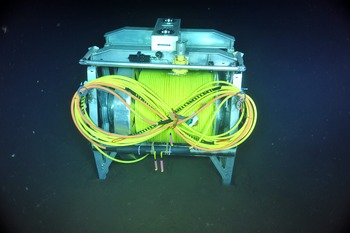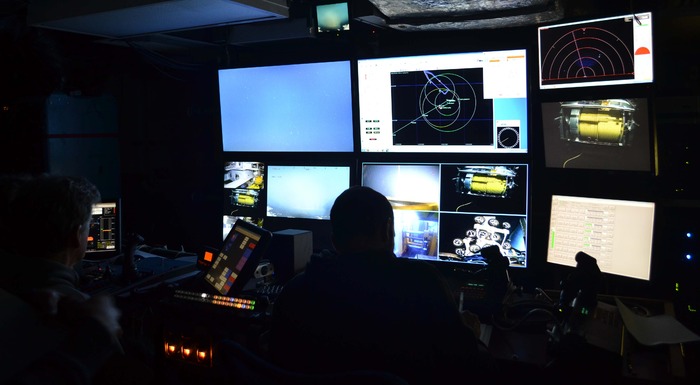
The Canadian ROV ROPOS is latched into the ROCLS cable laying system, taking a 1 km-long extension cable down to the seafloor at the base of Axial Seamount. Photo Credit: Mitch Elend, University of Washington, V14.

The ROCLS cable drum is unlatched on the seafloor at the base of Axial Seamount near PN3A at a depth of 2600 m. The cable, once plugged into a junction box and Primary Node, will power and communicate with ~2600 m-tall (8500 ft) instrumented moorings, as well as seafloor instruments. Photo Credit: NSF-OOI/UW/CSSF; Dive R1715; V14.
Today's activities focused on preparing to lay nearly 4000 ft of extension cable onto the seafloor and to deploy a junction box at a depth of 8530 ft beneath the ocean's surface at the base of Axial Seamount (Site PN3A).
In the early morning hours, a junction box (LV03A) was deployed near Primary Node PN3A. This will be used initially as an "anchor" to tie-off the cable so that the cable can be played out from behind the Remotely Operated Cable Laying System (ROCLS) that is coupled onto the underbelly of the ROV ROPOS.
Significant work happens prior to cable laying so that the cable is held in proper configuration on the cable drum. Each layer of cable on the drum is premarked so that, during the dive, operators can count the wraps as the cable comes off the drum. This allows operators to determine how much cable is laid out on the seafloor behind the vehicle. An additional 10 to 20 meters (up to 60 ft) of cable is mounted on "horns" on the front of the drum in a figure-8 configuration. These drums, with cables, can reach nearly 4000 lbs. Calm seas, therefore, are required for cable-laying operations.
To install cable onto the seafloor, ROPOS initially latches onto ROCLS, which is holding the cable drum, and descends to the seafloor. Once there, the ROV gently lands and unlatches the cable drum from the vehicle's underbelly. Using the force-feedback manipulators, the ROPOS pilots, sitting in the operations room on the ship, remove the 10 to 20 meters of figure-8 cable from the horns of the drum and then attach the end of the cable to the junction box with a Yale/Kellum grip. This spring-like tether prevents the cable from being pulled on by the ROV during the lay and hence prevents damage to the cable.
Once the Kellum grip is secured, ROPOS latches onto the drum again. The vehicle and the ship then do a highly orchestrated set of maneuvers to play the cable out gently behind the ROV. Typically ROPOS will "fly" about 30 meters (~100 ft) above the seafloor, very slowly playing out cable behind the vehicle. Near the end of the cable lay, the R/V Thompson slows down, and ROPOS very gently lands ROCLS onto a predetermined landing spot on the seafloor where a junction box will later be installed. ROPOS then unlatches the cable drum and pulls a couple pins from the side of the drum, which allows a "flange box" to drop to the seafloor. This box holds the terminus of the cable with an ODI wet-mate connector. ROPOS then latches back into the now-empty drum and surfaces.
These complex operations take amazing skill and attention to detail. Last year, during VISIONS '13, ROPOS installed over 14 miles of extension cables onto the seafloor. This year, during VISIONS '14, we will be connecting >15 junction boxes to these extension cables, which will provide power and communications to moorings, and instruments to be installed this summer.


